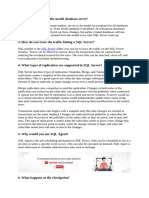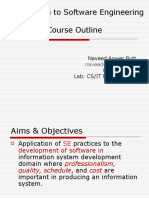SQL Server Auditing Quick Reference Guide
Uploaded by
vkiev3000SQL Server Auditing Quick Reference Guide
Uploaded by
vkiev3000Quick Reference Guide
SQL Server Auditing
SQL Server 2005-2014
Trace Creation
Run MS SQL Management Studio > Connect to database you want to Common SQL
audit > New Query > Copy the following script into new query box:
DECLARE @RC int, @TraceID int, @on BIT Trace Events:
12 – SQL:BatchCompleted
EXEC @rc = sp_trace_create @TraceID output, 2,
13 – SQL:BatchStarting
N'C:\pathname\file' 105 – Audit Login GDR Event
SELECT RC = @RC, TraceID = @TraceID 109 – Audit Add DB User Event
-- Follow Common SQL trace event list and common sql trace 110 – Audit Add Member to DB
Role Event
-- tables to define which events and tables you want to 111 – Audit Add/Drop Role
capture 113 – Audit Statement
Permission
SELECT @on = 1
128 – Audit Database
EXEC sp_trace_setevent @TraceID, 111, 1, @on Management Event
-- (111-Event Audit Add/Drop Role, 1-TextData table column) 131 – Audit Schema Object
Management Event
EXEC sp_trace_setevent @TraceID, 111, 11, @on 176 – Audit Server Object
EXEC sp_trace_setevent @TraceID, 111, 14, @on Management Event
EXEC @RC = sp_trace_setstatus @TraceID, 1 177 – Audit Server Principal
Management Event
GO
Common SQL
Define file trace location and hit “Execute” to start a new trace Trace Table
Columns:
Trace Management 1 – TextData
Execute this query to stop the trace: 6 – NTUserName
sp_trace_setstatus @traceid = 2, @status = 0 11 – LoginName
14 – StartTime
Execute this query to delete the trace: 15 – EndTime
sp_trace_setstatus @traceid = 2, @status = 2 26 – ServerName
35 – DatabaseName
You can find full events and tables
Execute this query in order to import the trace into database table: list here: url2open.com/sqltrace
USE DBname
SELECT * INTO tablename FROM ::fn_trace_gettable
('C:\pathname\file.trc', DEFAULT)
GO
Execute this query in order to view trace data:
SELECT TOP 1000 [TextData] ,[HostName] ,[LoginName] ,[StartTime] ,[EndTime] ,
[ServerName] ,[EventClass]
FROM [DBname].[dbo].[tablename]
Inspect “TextData” table for events like: CREATE LOGIN, ALTER SERVER
ROLE, DROP LOGIN etc...
Get #completevisibility into what's going on inside your Microsoft SQL
Server for free: netwrix.com/go/trial-ss
Corporate Headquarters: Toll-free: 888-638-9749 Int'l: 1-949-407-5125
300 Spectrum Center Drive, Suite 1100, EMEA: 44 (0) 203-318-0261 netwrix.com/social
Irvine, CA
You might also like
- FeasibilityStudy BulacanStateUniversity-1No ratings yetFeasibilityStudy BulacanStateUniversity-1202 pages
- Wrox Press - XSLT Programmer's Reference (2Nd Edition)0% (1)Wrox Press - XSLT Programmer's Reference (2Nd Edition)531 pages
- SQL Server Auditing Quick Reference Guide PDFNo ratings yetSQL Server Auditing Quick Reference Guide PDF1 page
- Identifying Performance Problems With SQL 2005 Profiler - Martin BellNo ratings yetIdentifying Performance Problems With SQL 2005 Profiler - Martin Bell36 pages
- Windows Server Auditing Quick Reference GuideNo ratings yetWindows Server Auditing Quick Reference Guide1 page
- SQL Server Performance Monitoring & OptimizationNo ratings yetSQL Server Performance Monitoring & Optimization44 pages
- Tara Kizer Database Administrator at Qualcomm, Inc. SQL Server MVPNo ratings yetTara Kizer Database Administrator at Qualcomm, Inc. SQL Server MVP10 pages
- SQL Server Profiler: Step by Step GuideNo ratings yetSQL Server Profiler: Step by Step Guide11 pages
- SQL Server: Collecting and Analyzing Trace Data Module 1: IntroductionNo ratings yetSQL Server: Collecting and Analyzing Trace Data Module 1: Introduction5 pages
- Implementing Auditing in SQL Server SQLSAT74No ratings yetImplementing Auditing in SQL Server SQLSAT7433 pages
- Tracking Data Changes: With Temporal Tables and MoreNo ratings yetTracking Data Changes: With Temporal Tables and More22 pages
- Netiq Appmanager For Microsoft SQL Server: Features & BenefitsNo ratings yetNetiq Appmanager For Microsoft SQL Server: Features & Benefits1 page
- SQL Server Performance Tuning and Monitoring TutorialNo ratings yetSQL Server Performance Tuning and Monitoring Tutorial52 pages
- Rsa Netwitness Platform: Microsoft SQL ServerNo ratings yetRsa Netwitness Platform: Microsoft SQL Server22 pages
- Top 10 SQL Server DBA Daily Checks v2 - 1 - by - SQLNetHubNo ratings yetTop 10 SQL Server DBA Daily Checks v2 - 1 - by - SQLNetHub5 pages
- SQL DBA Performance Tunning Book 1740934042No ratings yetSQL DBA Performance Tunning Book 174093404250 pages
- What Purpose Does The Model Database Serve?: SQL ServerNo ratings yetWhat Purpose Does The Model Database Serve?: SQL Server10 pages
- Professional SQL Server 2012 Internals and Troubleshooting 1st Edition Christian Bolton - The ebook is ready for download, no waiting required100% (1)Professional SQL Server 2012 Internals and Troubleshooting 1st Edition Christian Bolton - The ebook is ready for download, no waiting required42 pages
- BlackHat DC 09 Cerrudo SQL Anti Forensics SlidesNo ratings yetBlackHat DC 09 Cerrudo SQL Anti Forensics Slides38 pages
- Professional SQL Server 2012 Internals and Troubleshooting 1st Edition Christian Bolton pdf downloadNo ratings yetProfessional SQL Server 2012 Internals and Troubleshooting 1st Edition Christian Bolton pdf download57 pages
- Collect and Analyze Troubleshooting DataNo ratings yetCollect and Analyze Troubleshooting Data26 pages
- CHAPTER 01 Introduction To Professional Salesmanship100% (1)CHAPTER 01 Introduction To Professional Salesmanship9 pages
- Sida Meas, National and Semester Tests for Grade 12No ratings yetSida Meas, National and Semester Tests for Grade 1214 pages
- Introduction To Software Engineering Course Outline: Naveed Anwer Butt Office: A-207 Lab: CS/IT Research LabNo ratings yetIntroduction To Software Engineering Course Outline: Naveed Anwer Butt Office: A-207 Lab: CS/IT Research Lab17 pages
- Albury Line: Via Wangaratta, Benalla and SeymourNo ratings yetAlbury Line: Via Wangaratta, Benalla and Seymour4 pages
- Wonderful - Wizkid X Teni X Burna Boy X Afrobeat Type Beat (Prod by Cobby Dollar) - BasicWAV - ContractNo ratings yetWonderful - Wizkid X Teni X Burna Boy X Afrobeat Type Beat (Prod by Cobby Dollar) - BasicWAV - Contract5 pages
- Garvey Et Al-2006-Research in Nursing & Health PDFNo ratings yetGarvey Et Al-2006-Research in Nursing & Health PDF11 pages
- Old Exam Questions - Risk and Rates of Return - Solutions Page 1 of 62 PagesNo ratings yetOld Exam Questions - Risk and Rates of Return - Solutions Page 1 of 62 Pages62 pages
- Multiple Choice Questions On HTML CSS Javascript With AnswersNo ratings yetMultiple Choice Questions On HTML CSS Javascript With Answers10 pages
- God Is Love Chords by Marvin Gaye - Songsterr Tabs With RhythmNo ratings yetGod Is Love Chords by Marvin Gaye - Songsterr Tabs With Rhythm2 pages

























































































